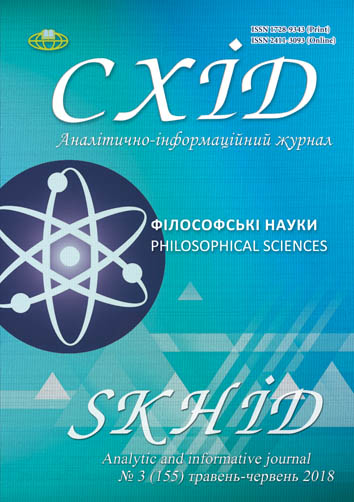The Leap of Faith: Transcendental Dialogue of Religious Culture of the Middle Ages and Globalization
DOI:
https://doi.org/10.21847/1728-9343.2018.3(155).139679Keywords:
culture, cultural mastery, faith, Middle Ages, life, dialogue, globalizationAbstract
The purpose of the study is the identification of structural elements of the Middle Ages to solve current problems , highlighting the transcendental dialogue as a guarantor of the future of Culture, the most relevant conditions of Ukraine's entry into the globalization process. Methodology. The following methods were used: analytical, historical, philosophy of dialogue as the most effective method of studying the meanings of interaction and exchange of cultural traditions, content analysis and theoretical method. Scientific innovation is to recognize the possibility of using the medieval art and forms of dialogue in the formation of the "Christian" model of globalization from the political and dogmatic point of view. Conclusions. A modern leap of faith is possible owing to strengthening faith in globalization, which can go through a difficult path from the faith and acceptance of globalization as the only way of development (socio-cultural level) to the faith in divine work of integration processes, its sacralization (religious and cultural level), and religious and dogmatic level of analysis is the perspective of the study. The spiritual atmosphere of the Middle Ages cultivated tolerance to another and severity to oneself, which may be one of the essential elements of having dialogues of global world. Ukrainian context of integration processes must be implemented not from declarative and perfect, only ideological but from practical dialogue concept. It can be implemented in the cultural policy of the state, which provides Multiculturalism of the integration processes at the legislative level and develops the Ukrainian national culture as well.Downloads
References
Saint Augustine. 1996. Confessions [translat.] Osnovy, Kyiv, 319 p. (ukr).
Bakhtin, M. M. 1990. Creativity Francois Rabelais and the folk culture of the Middle Ages and the Renaissance (2nd ed.). Khudozhestvennaya literatura,Moscow, 543 p. (rus).
Boethius. Ukolova, V.I. [translat.] and Tseitlin, M.N. [translat.] 1990. Consolation Philosophy and other treatises. Book 5. Naika.Moscow. URL: http://ancientrome.ru/antlitr/t.htm?a=1466700500 (Accessed: 20.04.2018).
Gerchanovskaya, P. E. 2015. Dialogization as a modern form of internationalization of social life. International Bulletin: Culturology, Philology, Musicology. Kyiv: Millennium, ІІ (5): 3-9 (ukr).
Gurevich, A. Ya. 1984. Categories of medieval culture. Iskusstvo.Moscow, 350 p. (rus).
Danylova, T. V. 2016. Theory of civilizations in the context of modern humanities. Antropolohichni vymiry filosofskykh doslidzhen. Issue 9: 55-62. URL: http://ampr.diit.edu.ua/article/view/72231/67500 (Accessed: 11.04.2018).
Fed V.A. 2009. Cultivating Being. " Pechatnyy dvor",Slavyansk: 288 p. (ukr).
Thomas Aquinas. 2002. The sum of theology.PartI.Questions 1-43 [translat.].Elga-NikaCenter, Kyiv: Elkor-MK,Moscow, 560 p. (rus).
Heyzinga, J. & Ukolova, V.I. [translat.] 1995. Autumn of the Middle Ages. Op. in 3 vols. Vol. 1. Publishing group "Progress" - "Culture", 1Moscow. 416 p. (rus).
Creative Economy Report 2013. Widening Local Development Pathways UNESCO & UNDP 184 р. URL: http://www.unesco.org/culture/pdf/creative-economy-report-2013.pdf. (Accessed: 01.04.2018).
Peters, J. D. 2001. Speaking into the Air: A History of the Idea of Communication. University of Chicago Press Pages, 304 p.
Downloads
Published
How to Cite
Issue
Section
License
Copyright (c) 2018 Volodymyr Fed

This work is licensed under a Creative Commons Attribution-NonCommercial-NoDerivatives 4.0 International License.
1. Authors bear responsibility for the accuracy of facts, quotations, numbers and names used.
2. Manuscripts are not sent back.
3. The publisher does not always agree with the authors' opinion.
4. The authors reserve the right to authorship of the work and pass the first publication right of this work to the journal under the terms of a Creative Commons Attribution-NonCommercial-NoDerivatives 4.0 International License. This license allows others to distribute (copy) the published work for non-commercial purposes, provided there is mandatory attribution to its authors and a link to the first publication in our journal.
5. The authors have the right to conclude separate supplement agreements that relate to non-exclusive work distribution in the form in which it has been published by the journal (for example, to upload the work to the online storage of the journal or publish it as part of a monograph), provided that the reference to the first publication of the work in this journal is included.

